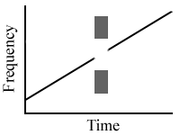
Illusory continuity of tones
Encyclopedia

Auditory illusion
An auditory illusion is an illusion of hearing, the aural equivalent of an optical illusion: the listener hears either sounds which are not present in the stimulus, or "impossible" sounds...
caused when a tone is interrupted for a short time (approximately 50ms or less), during which a narrow band of noise is played. The noise does, however, have to be of a sufficiently high level to effectively mask the gap, as can be seen in the audio example found here. Whether the tone is of constant, rising or decreasing pitch, the ear
Ear
The ear is the organ that detects sound. It not only receives sound, but also aids in balance and body position. The ear is part of the auditory system....
perceives the tone as continuous if the 50ms (or less) discontinuity is masked by noise. Because the human ear is very sensitive to sudden changes, however, it is necessary for the success of the illusion that the amplitude of the tone in the region of the discontinuity not decrease or increase too abruptly.
Most probably, this happens because of the way that the human ear adapted to filter out the background noise from signals (visual, acoustic, tactile,...) in order to show one signal disturbed by noise as one event, not several. (A longer change in the signal could mean a different event.)

